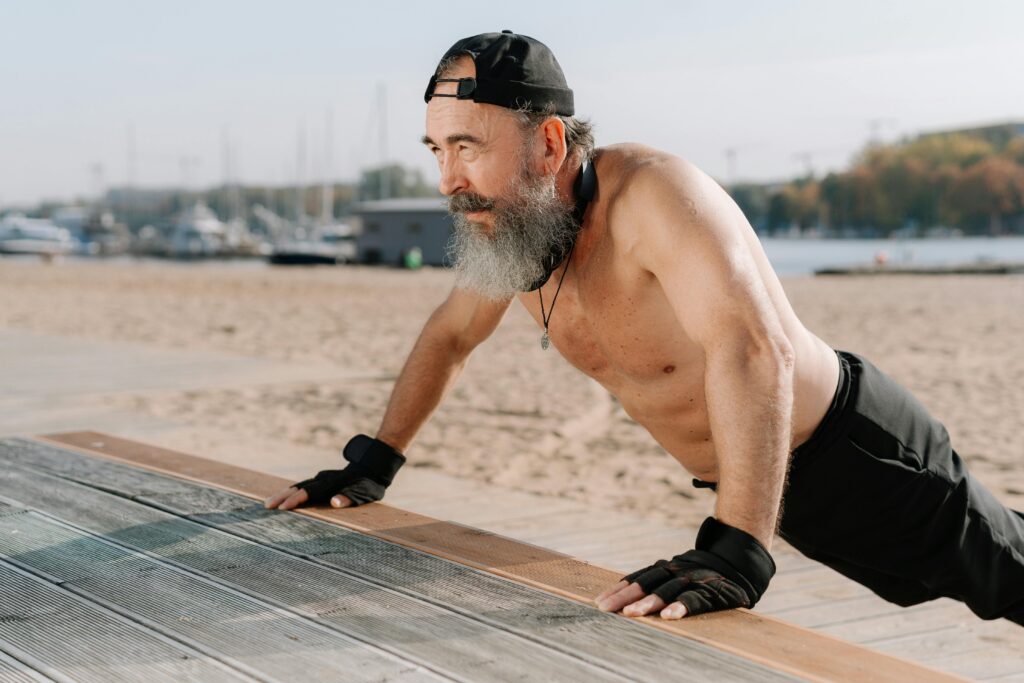Aging doesn’t mean losing strength or slowing down. In fact, targeted resistance training can help older adults build muscle, boost energy, and support overall health. Research shows that even simple strength workouts can improve balance, increase bone density, and lower the risk of chronic diseases.
This guide explains how strength training benefits older adults, offers practical tips to get started, and answers common questions to help you train safely and confidently.
Why Strength Training Matters as We Age
Strength training isn’t just for athletes. As we get older, our bodies naturally lose muscle mass (a condition called sarcopenia). Resistance exercises help slow and even reverse this process, which leads to:
- Improved muscle strength and coordination for daily tasks
- Stronger bones that reduce the risk of fractures
- Better balance to prevent falls and injuries
- Healthier heart and metabolism for more energy
Regular strength training has been linked to fewer falls, reduced joint pain, lower risk of heart disease, and improved mental clarity.
Key Health Benefits Backed by Research
Here’s a quick look at the evidence supporting strength training for older adults:
| Benefit | What the Research Shows |
| Muscle Mass Maintenance | Resistance training helps preserve muscle and reduce age-related muscle loss (sarcopenia). |
| Fall Prevention | Strength exercises improve balance and coordination, lowering fall risk. |
| Bone Density Increase | Weight-bearing moves stimulate bone formation, reducing fracture risk. |
| Cardiovascular Health | 30–60 minutes per week can lower heart disease risk by up to 17%. |
These physical improvements also support independence, mobility, and confidence—helping older adults stay active and engaged in daily life.
How Strength Training Boosts Energy and Vitality

Many older adults struggle with low energy, failed diets, or persistent fatigue. Often, this stems from a lack of effective resistance training. When muscles stay weak, metabolism slows, mental clarity fades, and energy drops.
Strength training addresses these challenges by:
- Improving metabolic function to support steady energy
- Enhancing mental clarity and focus
- Building confidence through better mobility and posture
Over time, even simple exercises like squats, push-ups, and planks can dramatically improve how you feel and move every day.
Supporting Your Training With Targeted Nutrition
As you build strength, proper nutrition becomes just as important as the workouts themselves. Many older adults benefit from adding a muscle-support supplement to their routine to help maintain progress and recovery.
STRONGHOLD is designed specifically to support lean muscle growth and protect against age-related muscle loss. It combines HMB to reduce muscle breakdown, creatine to boost endurance, and leucine to drive protein synthesis—all delivered through fast-absorbing whey protein isolate. Vitamin D supports muscle recovery, while vitamin K strengthens bones for lasting mobility.
Including a supplement like STRONGHOLD alongside regular strength training can:
- Accelerate muscle repair and recovery
- Support healthy bone density and joint mobility
- Improve endurance so you can stay consistent with your workouts
It’s not a replacement for exercise—but it can help you get the most from every session and build a strong foundation for long-term vitality.
Getting Started: Simple Tips for Success
Starting strength training can feel intimidating, but small steps add up quickly. Here’s how to make it easier:
- Set realistic goals – Begin with short sessions and build gradually.
- Choose safe home exercises – Try chair rises, wall push-ups, or resistance band workouts.
- Use digital coaching tools – Online videos and fitness apps can guide you.
- Track your progress – Keep a log to stay motivated and accountable.
- Find social support – Join a local senior fitness class or community group.
Consistency is more important than intensity. Focus on proper form, slow controlled movements, and listening to your body.
Staying Safe While Building Strength
Safety is key for long-term success. To prevent injury:
- Warm up before every session
- Use light weights or resistance bands to start
- Focus on correct form, not speed
- Allow rest days between sessions
- Check with your doctor before starting if you have health concerns
With the right approach, strength training can be safe, enjoyable, and life-changing at any age—even well into your 70s and beyond.
The Takeaway
Strength training is one of the most effective ways for older adults to stay active, energetic, and independent. It builds muscle, strengthens bones, improves balance, and boosts overall well-being. By starting small, staying consistent, and supporting your body with proper nutrition, you can reclaim your strength and vitality at any age.
Commit to just a few short sessions each week—and enjoy a healthier, more vibrant future.
FAQ: Strength Training for Older Adults
Q: How often should seniors do strength training?
A: Aim for 2–3 sessions per week, with at least one rest day between. Pair this with 150 minutes of moderate aerobic activity each week.
Q: Can I start strength training at age 70?
A: Absolutely. Many older adults regain strength and muscle tone with modified exercises tailored to their abilities.
Q: What are safe strength exercises to do at home?
A: Try wall push-ups, chair rises, seated bicep curls, or gentle squats. Use resistance bands or light weights.
Q: Is strength training better than cardio for seniors?
A: Both are important, but strength training directly targets age-related muscle loss and bone density.
Q: How can I avoid injuries?
A: Warm up, use light resistance at first, progress slowly, and focus on form. Stop if you feel pain.
